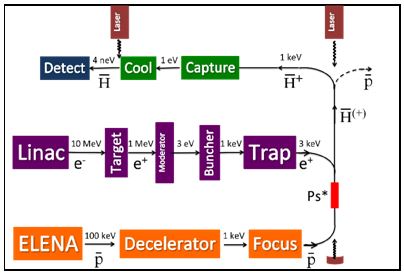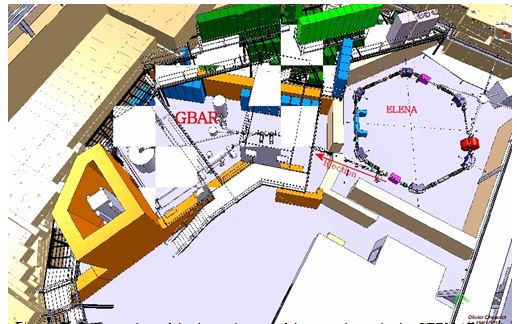GBAR - Gravitational Behavior of Antimatter at Rest
The GBAR experiment, proposing a gravity measurement of antihydrogen at the planned ELENA facility, was approved by the Research Board in May 2012. The collaboration is formed of 14 laboratories and about 40 researchers at present1.
The goal of GBAR is to test the Einstein Weak Equivalence Principle (WEP), which states that the trajectory of a test particle is independent of its composition and internal structure when it is only submitted to gravitational forces. This fundamental principle has never been directly tested with antimatter. GBAR will measure the free-fall acceleration g of neutral antihydrogen atoms in the terrestrial gravitational field directly. [1]
The main principle of GBAR is the use of antihydrogen H+ ions (the antimatter equivalent of H– ions) to more easily manipulate the atoms before measurement. Once produced, the H+ ions are cooled in two stages with lasers and Paul traps to µK temperatures, i.e. a 1 m/s velocity. We then neutralize them by photo-detachment and let the H atoms fall (Fig. 1). From a 20 cm height the time of flight is 200 ms, thus easily measured. This is complementary to the method used by the AEGIS experiment, already in preparation, that will produce a broad beam of Hs at a velocity of about 103 m/s and detect tens of µm deviations due to gravity using a deflectometer. Both experiments aim at a 1% precision in the first phase.
Our method opens the possibility of performing a spectroscopy of H quantum states. Indeed, an experiment performed ten years ago at ILL Grenoble with ultra cold neutrons by our collaborators showed that these neutrons, launched a few tens of µm above a plate, were reflected from this surface by the Casimir effect, and even trapped in the potential resulting from gravity. In such a potential well the energy levels accessible to the trapped particle are quantized, i.e. the distributionof the altitudes reached after bouncing on the surface by the particles is quantized. The separation between these altitude levels is proportional to the acceleration due to gravity. It was calculated thatantihydrogen atoms of low vertical velocity when arriving on such a plate, i.e. launched a few tens of microns above it, would be reflected with very high probability, allowing thus to use the same technique to measure g with much higher precision.

Principle of free-fall measurement (left) and H+ production scheme (right)
Experimental method:
The H+ ion is produced through two charge-exchange processes from interactions of p and H with the same positronium (Ps) target (the positronium is an e+e-bound state):
p + Ps →H + e-(1)
H + Ps →H++ e-. (2)
The first formation cross-section may be enhanced if positronium is slightly excited (n = 2 or 3), for incident antiproton energies between 1 and 6 keV. Preliminary calculations optimising the time delays between the antiproton, positron and laser pulses, show that 1H free fall can be detected per ELENA pulse, i.e every 100 s.
The Ps target itself is formed by the interaction of a positron bunch with a nanoporous SiO2layer (Fig. 1 right). We developed a layer that converts more than 30% of the incident 3 keV e+into orthopositronium (o-Ps) that is released into the vacuum. The o-Ps areal density required to obtain of the order of 1 H+ion per ELENA pulse, is ~ 1012cm-2. This cannot be accomplished with the β+ emitters such as the 22Na sources used by the other antihydrogen experiments. Instead, a compactelectron linac produces positrons by pair production in a target with intensity up to 100 times higher. On the other hand, the antiprotons that are decelerated in a first step to 5 MeV in the AD, then to 100 keV in ELENA, must be further decelerated to a few keV.

Figure 2 - Schematic illustration of the GBAR experiment. The MeV and keV values are mean kinetic energies, while the eV and neV values are dispersions, i.e. temperatures, or quantum levels
The steps needed to perform the gravitation experiment are sketched in figure 2:
- Production of an intense flux of fast positrons (few MeV) from the interactions on a tungsten target of a 10-20 MeV electron beam produced in a small accelerator.
- Selection of the positrons and suppression of the electron and gamma background with a magnetic separator.
- Moderation of the positrons to create so-called “slow” positrons of a few eV.
- Accumulation of the positrons inside a 5 Tesla Penning-Malmberg trap, where they cool down to a few meV and are then ejected in less than 100 ns onto a porous silica target to form a dense ortho- positronium cloud.
- Excitation of the o-Ps to gain a large factor on their cross section for the production of H+.
- Interaction with the very low-energy antiproton beam extracted from the Antiproton Decelerator(AD) followed by the ELENA ring at CERN and an electrostatic decelerator: this produces H atoms and H+ions.
- Accumulation of the H+ions and sympathetic cooling with 9Be+ions to 10 μK.
- Photo-detachment at the threshold of the extra positron.
- Measurement of the free fall of the anti-hydrogen atom.
Let us note that the final step reaches energy levels of a few neV, while the original proton beam that forms the antiprotons in the PS is 26 GeV, i.e about 19 orders of magnitude reduction in energy!
Ongoing R&D activities:
The most advanced ongoing activities are detailed below, while the other experimental steps are being prepared at Grenoble, Mainz, Paris, Swansea, Swierk, Tokyo and Zurich. We also have a few theorists interested in improving particle trapping, studying positron and positronium interactions, and in the quantum reflection with antimatter.


Figure 3 - (left) schematic and (right) photograph of the decelerator test bench in Orsay.
The antiprotons that will be delivered in 2017 by the Antiproton Decelerator, followed by the ELENA ring, will have a 100 keV kinetic energy. This is still too high, so that all the present antihydrogen experiments capture the antiprotons after a degrader into a Penning trap where they are cooled. In GBAR, we propose to reduce the kinetic energy from 100 keV to 1 keV while focusing the beam onto the 1 mm diameter tube that will contain the Ps target. The technique is to rapidly pulse up a beam-tube cavity from -99 kV to 0 kV while the p bunch is inside so that the antiprotons feel no electric potential gradient when they exit. The idea of decelerating the antiprotons from 100 keV to 1 keV is to circumvent the losses that occur when using energy degraders as well as avoiding another Penning trap for accumulation. Such electrostatic decelerators are routinely used with heavy-ion beams at the CERN-ISOLDE facility. We have set up a test bench with protons at the CSNSM in Orsay to develop the necessary deceleration and focusing elements for the antiproton beam pulses. A schematic illustration and photograph are shown in Fig. 3.

Figure 4 - Lauout at Saclay (left) and picture of beamline connecting the Penning trap (lefT)
In order to test positron production and accumulation, we have set up a demonstration apparatus in Saclay that is based on a small electron linac of 4.3 MeV and 0.14 mA average current running at 200 Hz repetition rate with effective bunch length of 2.5 µs. A primary target is followed with a tungsten mesh moderator producing 3 106 slow e+/s. These positrons of a few eV are transported to a switch where they can be directed either towards a Penning-Malmberg trap for accumulation or towards a positron annihilation spectrometer (see Fig. 4). In this spectrometer, the e+to Ps conversion process can be studied in detail.
The trap was transported from the Atomic Physics Laboratory of RIKEN (Japan) and connected to the slow positron beam line in June 2012. The setup is now ready for systematic tests of the trapping mechanism that involves cooling the positrons with a preloaded electron plasma.
Once the accumulation of positrons is finished, they are ejected from the trap and dumped onto the porous silica to be converted into positronium. A laser system is being prepared by LKB in Paris to excite this Ps cloud. Note that the lifetime of o-Ps being 142 ns, the dump must be performed quickly and the p, e+and laser beams must be synchronised accordingly.
In the secondary beam line, the slow positrons can be made to interact with material samples that we want to study for improving the conversion into positronium. BGO crystals detect the gamma rays emitted in the decay of positronium. The trigger is provided by the secondary electrons emitted when the incident positron hits the sample to be studied. This scheme was already successfully used in an ETHZ beam.
GBAR at CERN:
A preliminary layout in the AD Hall is shown in Fig. 5, where the ELENA beam exits the ring to the left and is transported through two quadrupole doublets to the electrostatic decelerator. The low-energy antiprotons are then deflected left into the reaction chamber. The linac, shown on the lower left (surrounded by shielding) is used to create positrons that are sent to the Penning trap (center) and the accumulated pulse is deflected to the right, into the reaction chamber to form the positronium cloud. The cylinder on the left houses both the antihydrogen capture and cooling traps, with the free-fall detector located around. Also visible are two mezzanines that will house the laser systems for positronium excitation (right) and cooling and photo-detachment (left).
We aim at preparing the elements of the experiments in order to be ready for the first proton or H- beams that will be used for the commissioning of ELENA in 2016, and take the first antiproton data in 2017.

Figure 5 - Present view of the future layout of the experiment in the CERN AD hall.
References:
[1] G. Chardin et al, Proposal to measure the Gravitational Behaviour of Antihydrogen at Rest GBAR,
CERN-SPSC-P-342, September 2011;
http://cdsweb.cern.ch/record/1386684/files/SPSC-P-342.pdf
1 CSNSM Orsay, ETH Zurich, ILL Grenoble, IPCMS Strasbourg, IRFU Saclay, Lebedev Moscow, LKB Paris, JGU Mainz, NCBJ Otwock-‐Swierk, RIKEN, Swansea University, University of Tokyo Komaba, Tokyo University of Science, Uppsala University.
